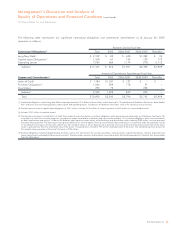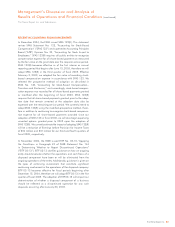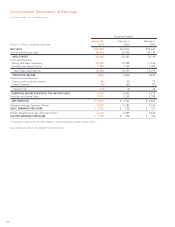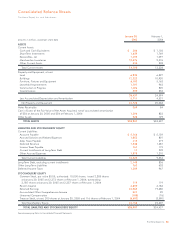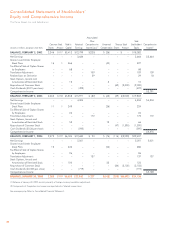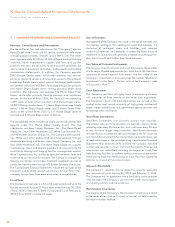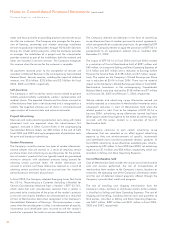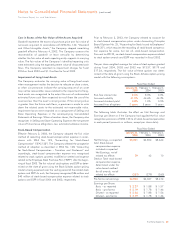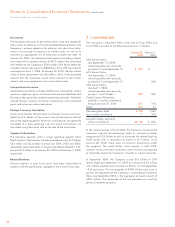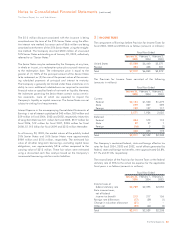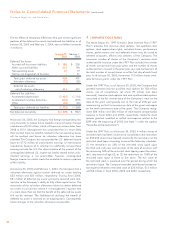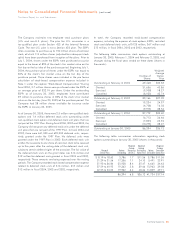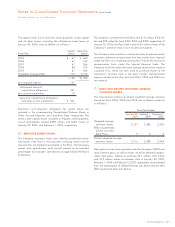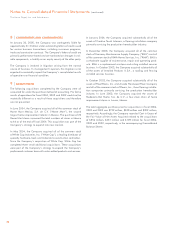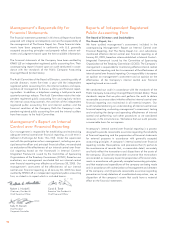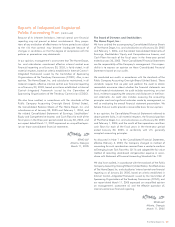Home Depot 2004 Annual Report Download - page 33
Download and view the complete annual report
Please find page 33 of the 2004 Home Depot annual report below. You can navigate through the pages in the report by either clicking on the pages listed below, or by using the keyword search tool below to find specific information within the annual report.
Notes to Consolidated Financial Statements (continued)
The Home Depot, Inc. and Subsidiaries
31The Home Depot, Inc.
Cost in Excess of the Fair Value of Net Assets Acquired
Goodwill represents the excess of purchase price over fair value of
net assets acquired. In accordance with SFAS No. 142, “Goodwill
and Other Intangible Assets,” the Company stopped amortizing
goodwill effective February 4, 2002. The Company assesses the
recoverability of goodwill at least annually by determining
whether the fair value of each reporting entity supports its carrying
value. The fair values of the Company’s identified reporting units
were estimated using the expected present value of discounted cash
flows. The Company recorded no impairment charges for fiscal
2004 or fiscal 2003 and $1.3 million for fiscal 2002.
Impairment of Long-Lived Assets
The Company evaluates the carrying value of long-lived assets
when management makes the decision to relocate or close a store,
or when circumstances indicate the carrying amount of an asset
may not be recoverable. Losses related to the impairment of long-
lived assets are recognized to the extent the sum of undiscounted
estimated future cash flows expected to result from the use of the
asset are less than the asset’s carrying value. If the carrying value
is greater than the future cash flows, a provision is made to write
down the related assets to the estimated net recoverable value.
Impairment losses were recorded as a component of Selling and
Store Operating Expenses in the accompanying Consolidated
Statements of Earnings. When a location closes, the Company also
recognizes in Selling and Store Operating Expenses the net present
value of future lease obligations, less estimated sublease income.
Stock-Based Compensation
Effective February 3, 2003, the Company adopted the fair value
method of recording stock-based compensation expense in accor-
dance with SFAS No. 123, “Accounting for Stock-Based
Compensation” (“SFAS 123”). The Company selected the prospective
method of adoption as described in SFAS No. 148, “Accounting
for Stock-Based Compensation – Transition and Disclosure” and
accordingly, stock-based compensation expense was recognized
related to stock options granted, modified or settled and expense
related to the Employee Stock Purchase Plan (“ESPP”) after the begin-
ning of fiscal 2003. The fair value of stock options and ESPP as deter-
mined on the date of grant using the Black-Scholes option-pricing
model is being expensed over the vesting period of the related stock
options and ESPP. As such, the Company recognized $86 million and
$40 million of stock-based compensation expense related to stock
options and ESPP in fiscal 2004 and 2003, respectively.
Prior to February 3, 2003, the Company elected to account for
its stock-based compensation plans under Accounting Principles
Board Opinion No. 25, “Accounting for Stock Issued to Employees”
(“APB 25”), which requires the recording of stock-based compensa-
tion expense for some, but not all, stock-based compensation.
Pursuant to APB 25, no stock-based compensation expense related
to stock option awards and ESPP was recorded in fiscal 2002.
The per share weighted average fair value of stock options granted
during fiscal 2004, 2003 and 2002 was $13.57, $9.79 and
$17.34, respectively. The fair value of these options was deter-
mined at the date of grant using the Black-Scholes option-pricing
model with the following assumptions:
Fiscal Year Ended
January 30, February 1, February 2,
2005 2004 2003
Risk-free interest rate 2.6% 3.0% 4.0%
Assumed volatility 41.3% 44.6% 44.3%
Assumed dividend yield 0.8% 1.0% 0.5%
Assumed lives of options 5 years 5 years 5 years
The following table illustrates the effect on Net Earnings and
Earnings per Share as if the Company had applied the fair value
recognition provisions of SFAS 123 to all stock-based compensation
in each period (amounts in millions, except per share data):
Fiscal Year Ended
January 30, February 1, February 2,
2005 2004 2003
Net Earnings, as reported $5,001 $4,304 $3,664
Add: Stock-based
compensation expense
included in reported
Net Earnings, net of
related tax effects 79 42 10
Deduct: Total stock-based
compensation expense
determined under fair
value based method
for all awards, net of
related tax effects (237) (279) (260)
Pro forma net earnings $4,843 $4,067 $3,414
Earnings per Share:
Basic – as reported $2.27 $1.88 $1.57
Basic – pro forma $2.19 $1.78 $ 1.46
Diluted – as reported $ 2.26 $ 1.88 $ 1.56
Diluted – pro forma $ 2.19 $ 1.78 $ 1.46


